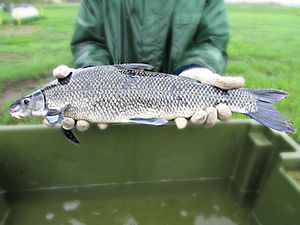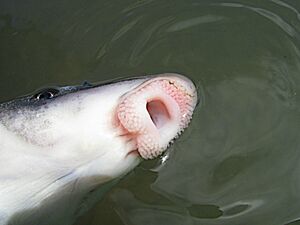Blue sucker facts for kids
Quick facts for kids Blue sucker |
|
|---|---|
 |
|
| Conservation status | |
| Scientific classification | |
| Synonyms | |
|
The blue sucker (Cycleptus elongatus) is a cool freshwater fish. It belongs to the sucker family. This fish can live for a very long time. Scientists are a bit worried about its future.
Blue suckers usually weigh about 2 to 3 kilograms (4.4 to 6.6 pounds). They grow to be around 76 centimeters (30 inches) long. The longest one ever found was 84 centimeters (33 inches). Some blue suckers have even lived for more than 40 years!
Contents
What Does the Blue Sucker Look Like?
The blue sucker's color can change. It might be light gray or almost black, especially in spring. This fish has a sleek, smooth body shape. Its mouth is on the underside of its head. This helps it find food on the river bottom.
Its head is small and narrow. It ends in a soft, fleshy snout. The body is long and a bit flat from side to side. It has a long, curved dorsal fin on its back. This fin has 24 to 35 rays. The tail section, called the caudal peduncle, is long. Its tail fin is forked, like a "V" shape. The fin on its belly, the anal fin, usually has 7 or 8 rays. Blue suckers have large scales. There are about 55 to 58 scales along their lateral line.
Where Do Blue Suckers Live?
Blue suckers are found in the United States and Mexico. In the U.S., they live in the Mississippi River basin. You can find them as far north as Minnesota and Wisconsin. They also live in the Missouri River system. This includes areas up to North Dakota, South Dakota, and Montana. You can also find them in rivers that flow into the Gulf of Mexico. These rivers stretch from the Sabine River to the Rio Grande.
Blue Sucker Homes
These powerful fish used to travel huge distances. They would migrate throughout the Mississippi River basin. Early settlers even relied on blue suckers for food in the spring. Today, blue suckers are quite rare. This is mainly because of the many dams built over the last 100 years. These dams block their migration paths. Blue suckers like to live in the deepest parts of large rivers. They prefer areas with strong currents.
What Do Blue Suckers Eat?
Blue suckers use their special mouth to eat food from the river bottom. They enjoy eating tiny aquatic insect larvae. They also munch on small crustaceans. Sometimes, they eat plant materials and algae.
How Do Blue Suckers Reproduce?
Blue suckers usually spawn, or lay eggs, from March to June. The exact time depends on where they live and the water temperature. Males and females look for spawning areas when the water is around 53 degrees Fahrenheit (11.7 degrees Celsius). They like fast-moving water that is about two feet deep. The rocks in these areas are bigger than gravel but smaller than boulders.
The busiest spawning time is when the water reaches 62 degrees Fahrenheit (16.7 degrees Celsius). The actual spawning period usually lasts about two weeks. Male suckers will keep coming to the area until all the eggs are laid. Females visit the area to lay their eggs. Once their eggs are fertilized, they leave. Scientists have recently learned that blue suckers don't always have new babies every year. Also, they live longer than people thought before.
Protecting the Blue Sucker
Blue suckers are very sensitive to water pollution. They can only live in clean, well-flowing water. This is why you often find them in rivers. This fish is in danger in many U.S. states. Its protection status in other states probably needs to be checked again.
Fun Facts About the Blue Sucker
The blue sucker has many other names! Some people call it the blackhorse. Other names include the bluefish, the razor back, or the sockerel. It's also known as the gourd seed sucker, the Missouri Sucker, the slenderhead sucker, and the sweet sucker.
What Do Their Names Mean?
The name "Cycleptus" comes from a Greek word. It means circular or slender. "Elongatus" is a Latin word. It means elongated, which describes its long body.




